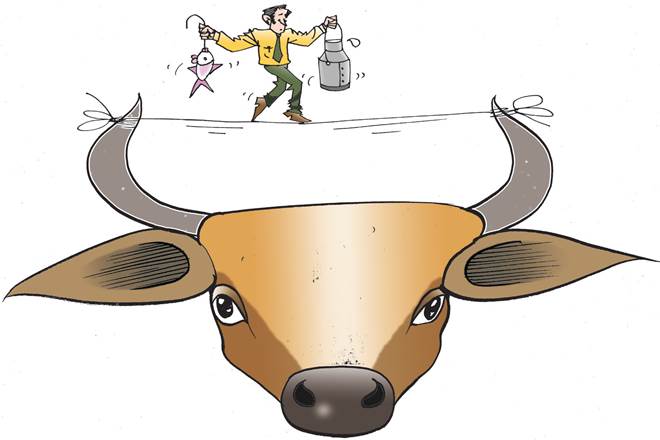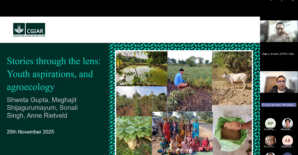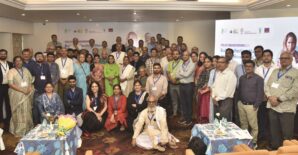Anjani Kumar, Smriti Verma and Arabinda K Padhee
 The creation of a separate ministerial portfolio for animal husbandry, dairying and fisheries for the first time by Prime Minister Narendra Modi in his second term has aroused interest amongst enthusiasts in the agricultural policy space. With the dominant narrative of doubling farmers’ incomes by 2022 in the overall policy framework, and livestock and fisheries sub-sectors contributing significantly higher to the agricultural GDP compared to the crop production sub-sector, the subtle governance move has been hailed by stakeholders, mostly in the dairy industry. India being the largest milk producer in the world surely deserved to have a separate line ministry dedicated to the sector, after all.
The creation of a separate ministerial portfolio for animal husbandry, dairying and fisheries for the first time by Prime Minister Narendra Modi in his second term has aroused interest amongst enthusiasts in the agricultural policy space. With the dominant narrative of doubling farmers’ incomes by 2022 in the overall policy framework, and livestock and fisheries sub-sectors contributing significantly higher to the agricultural GDP compared to the crop production sub-sector, the subtle governance move has been hailed by stakeholders, mostly in the dairy industry. India being the largest milk producer in the world surely deserved to have a separate line ministry dedicated to the sector, after all.
The erstwhile Department of Animal Husbandry, Dairying and Fisheries (DAHDF) was responsible for overseeing matters related to livestock production, preservation, protection from diseases, improvement of stocks, dairy development, and also matters pertaining to the Delhi Milk Scheme, the National Dairy Development Board, and inland and marine fishing and fisheries. It advised state governments and Union Territories on formulation of policies and programmes related to animal husbandry, dairy development and fisheries. Formed in February 1991, the department came under the purview of the ministry of agriculture and farmers’ welfare. Earlier this year, a new department called the Department of Fisheries was created out of the erstwhile DAHDF. While the mandate of the new ministry is yet to be elucidated, this could ‘potentially’ be a welcome move.
The ‘allied’ sectors of the usual ‘agriculture and allied’, as is common in official and academic parlance, have largely been neglected for a long time despite their growing significance in agricultural economy and food and nutrition security of the country. The importance of animal husbandry, dairying and fisheries can hardly be overstated in times when agricultural diversification is being rallied as one the most important drivers of growth in rural incomes and realising the PM’s vision of doubling farmers’ income. The 19th Livestock Census (2012) counted a total livestock population of 512.06 million. Livestock and fisheries have together registered an average annual growth rate of six times more than that in the crop sector between 2012-13 and 2016-17. Livestock, fishing and aquaculture account for nearly 32% of the overall agricultural GDP and 5% of national GDP. Livestock and fish products together contribute over Rs 7 lakh crore to total value of the agricultural output—nearly double the contribution of cereals and pulses together. While the share of crops in the value of agricultural output has been declining, that of livestock and fish products is on a steadily upward trend.
However, the policy focus and incentive structure in agriculture is highly skewed in favour of crop cultivation. Agricultural policies were bent towards foodgrain cultivation to overcome the food shortage crisis in the mid-1960s. However, long after attaining self-sufficiency and even surplus production, agricultural policies have remained undesirably crop-centric. Packages of benefits, such as the Kisan Credit Cards (KCC), interest subsidies on farm loans, etc, targeted at the welfare of the farming community have remained confined to those cultivating crops till recently. The KCC scheme was launched in 1998 and this facility was extended to livestock and fish farmers in 2018—after a long gap of 20 years. Even the most recent Pradhan Mantri Kisan Samman Nidhi (PM-KISAN) for providing income support of Rs 6,000 is targeted at farmers who are engaged in cultivation of crops. The new ministry could work to extend these benefits even to those engaged exclusively in the allied sectors. The definition of the ‘farmer’ has to be relooked and the ministry can play a pivotal role in mainstreaming these allied or orphaned sub-sectors. It is expected that with the creation of the new ministry, both the departments under it will have significantly higher budget allocations for existing and new schemes/programmes, as also investments and establishment of infrastructure in the value chain. Buffalo meat and inland/sea-fish exports having a huge share in our agri-exports basket are expected to get the required attention by the new ministry in coordination with the ministry of commerce.
There are, however, several challenges to deal with—and this is why we call the move ‘potentially’ welcome. Creation of a new ministry for livestock, dairying and fisheries has chances of further dissociating these from an integrally linked and rather mainstreamed activity of crop cultivation. The livestock production system is closely interwoven with crop sector in India. Usually a single-window system is preferred for better coordination, policy synchronisation and a general holistic approach. With the creation of a new ministry, the already subpar coordination between departments is under threat of getting worse. This also might encourage the fisheries department to lobby for a separate ministry of its own, especially with the growing emphasis on Blue Revolution in India. How research organisations, think tanks, donors and academia in general will align and coordinate their activities with other government and quasi-government organisations (such as the Indian Council of Agricultural Research) that are cross-cutting in their scope and agenda is something that will have to be figured out in the coming days. We strongly feel that the current move should not lead to a similar bifurcation of the National Agricultural Research System (NARS) into separate agencies of agriculture and veterinary/fisheries streams. The research ecosystem should not be equated with the governance structure of implementing departments.
While many speculate the move to have political undertones, if it can do the trick to shift the blinkered-focus of policymakers from crop cultivation to these emerging sectors, it will have well-served its purpose. Institutions once created tend to persist. It is, therefore, hoped that the objective behind the creation of this new ministry has been well-thought-through. Otherwise, it will just become another curious case of maximum government and minimum governance!
(Kumar and Verma are agricultural economists at the South Asia Office of the International Food Policy Research Institute, and Padhee is country director-India at the International Crops Research Institute for the Semi-arid Tropics based in Delhi. Views are personal)
This post was originally published in Financial Express



